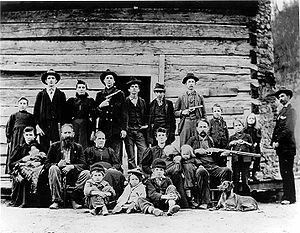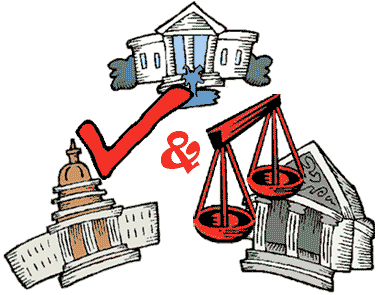a quarterback is harried by the defense, and so makes a bad pass;
a girl is pressured by her trusted friends to smoke pot;
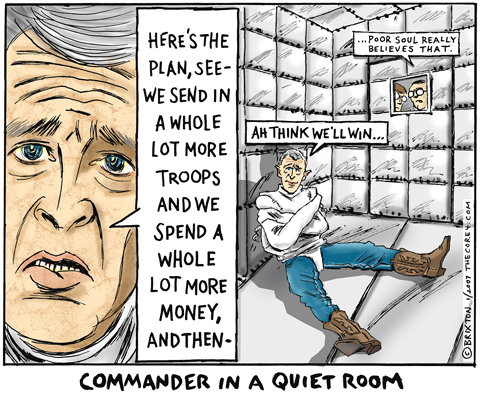
|
An automobile turns out to be a lemon, and repair after repair is made with no end in sight; or a war (whatever!). |
in Pavlov's case, a dog was trained to salivate at the sound of a bell, because the bell became associated with the arrival of food:
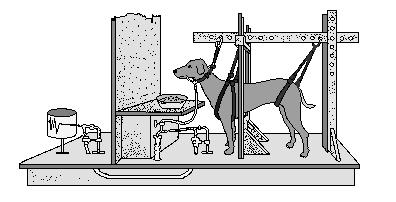
|
A famous example is provided by the story of the Hatfields and
the McCoys in American history of the 1800s: a dispute over a pig
leads to the killing of one family member by by another family; in
retribution, the victim's family kills a family member of the
murderous family; and so on, ad infinitum and ad
nauseam....
The good news is that, in the case of the Hatfields and the McCoys, a truce was eventually called. No such good news when you're talking about the effects of disabilities in many cultures. The kids are treated as second class citizens, and so become more and more so as the cycle spirals. |
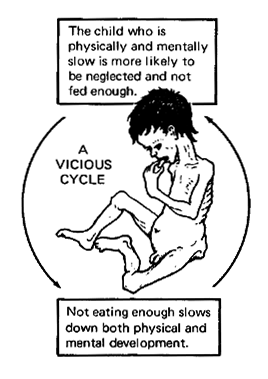
|
| "Ducking the Witch
[Trial by water]
One 'foolproof' way to establish whether a suspect was a witch was ducking. With right thumb bound to left toe, the accused was plunged into a convenient pond. If he or she floated it proved an association with the black arts, with the body rejecting the baptismal water. If the victim drowned they (sic) were innocent. Given the curious position of the prisoner, it was more likely they would float (Farrington 58)." (http://www.shanmonster.com/witch/traits/ducking.html) But then you'd be declared a witch, and so killed. So you were "damned if you do, damned if you don't," another good phrase exemplifying a catch-22. |
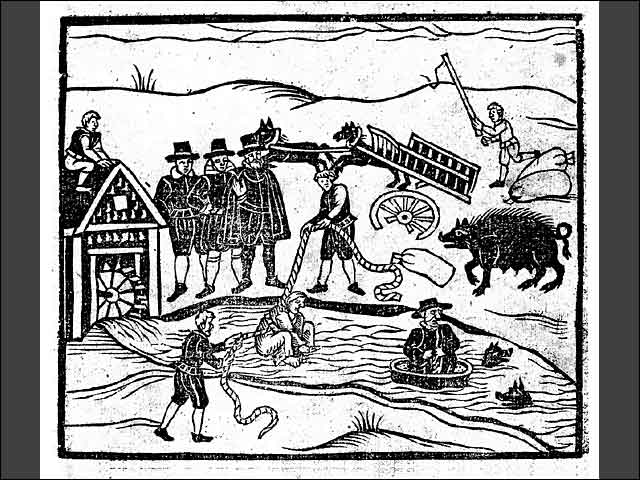
| A "witch" was "cleared" in 2006, who'd been convicted by ducking in 1701! |
a person is prescribed a painkiller, which is perfectly reasonable. But the drug is addictive, and the person may find that their drug use causes them behave in conflict with society. This leads them to do more drugs, to ease this new pain, which increases their alienation, etc. Eventually they end up dead. My favorite pop culture version of this is John Prine's Sam Stone.
Here's another good one, cited on the from the weather underground:
It was autumn, and the Indians on the remote reservation asked their new Chief if the winter was going to be cold or mild. Since he was a new Indian Chief in a modern society, he had never been taught the old secrets, and when he looked at the sky, he couldn't tell what the weather was going to be. Nevertheless, to be on the safe side, he replied to his tribe that the winter was indeed going to be cold and that the members of the village should collect wood to be prepared. But also being a practical leader, after several days he got an idea. He went to the phone booth, called the National Weather Service and asked,
"Is the coming winter going to be cold?"
"It looks like this winter is going to be quite cold indeed," the meteorologist at the weather service responded.
So the Chief went back to his people and told them to collect even more wood in order to be prepared. A week later he called the National Weather Service again.
"Is it going to be a very cold winter?"
"Yes," the man at National Weather Service again replied, "it's going to be a very cold winter."
The Chief again went back to his people and ordered them to collect every scrap of wood they could find. Two weeks later he called the National Weather Service again.
"Are you absolutely sure that the winter is going to be very cold?"
"Absolutely," the man replied. "It's going to be one of the coldest winters ever."
"How can you be so sure?" the Chief asked.
The weatherman replied, "The Indians are collecting wood like crazy!"
anyone stuck in a traffic circle should be able to understand this one!;)
The domino theory has close ties to the mathematical idea of induction (see for example this site).
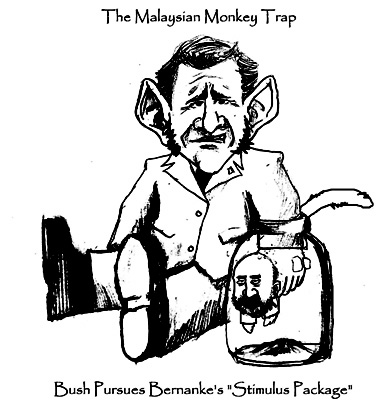 From The Schiller Institute |
this from Will The End of Oil Mean The End of America?:
"In Zen and the Art of Motorcycle Maintenance, Robert Pirsig tells the story of a South American Indian tribe that has devised an ingenious monkey trap. The Indians cut off the small end of a coconut and stuff it with sweetmeats and rice. They tether the other end to a stake and place it in a clearing. "Soon, a monkey smells the treats inside and comes to see what it is. It can just barely get its hand into the coconut but, stuffed with booty, it cannot pull the hand back out. The Indians easily walk up to the monkey and capture it. Even as the Indians approach, the monkey screams in horror, not only in fear of its captors, but equally as much, one imagines, in recognition of the tragedy of its own lethal but still unalterable greed." The author (Robert Freeman) goes on to give us his take on the message: "Pirsig uses the story to illustrate the problem of value rigidity. The monkey cannot properly evaluate the relative worth of a handful of food compared to its life. It chooses wrongly, catastrophically so, dooming itself by its own short-term fixation on a relatively paltry pleasure. "America has its own hand in a coconut, one that may doom it just as surely as the monkey. That coconut is its dependence on cheap oil in a world where oil will soon come to an end. The choice we face (whether to let the food go or hold onto it) is whether to wean ourselves off of oil to quickly evolve a new economy and a new basis for civilization or to continue to secure stable supplies from the rest of the world by force." |
Of course the monkey trap is a wonderful piece of bad dynamics that applies to hundreds of situations. I thought of it recently in the context of Jesus' story of the rich young man. Here it is, in the King James Version:
Mar 10:17 And when he was gone forth into the way, there came one running, and kneeled to him, and asked him, Good Master, what shall I do that I may inherit eternal life?
Mar 10:18 And Jesus said unto him, Why callest thou me good? there is none good but one, that is, God.
Mar 10:19 Thou knowest the commandments, Do not commit adultery, Do not kill, Do not steal, Do not bear false witness, Defraud not, Honour thy father and mother.
Mar 10:20 And he answered and said unto him, Master, all these have I observed from my youth.
Mar 10:21 Then Jesus beholding him loved him, and said unto him, One thing thou lackest: go thy way, sell whatsoever thou hast, and give to the poor, and thou shalt have treasure in heaven: and come, take up the cross, and follow me.
Mar 10:22 And he was sad at that saying, and went away grieved: for he had great possessions.
Mar 10:23 And Jesus looked round about, and saith unto his disciples, How hardly shall they that have riches enter into the kingdom of God!
Mar 10:24 And the disciples were astonished at his words. But Jesus answereth again, and saith unto them, Children, how hard is it for them that trust in riches to enter into the kingdom of God!
Mar 10:25 It is easier for a camel to go through the eye of a needle, than for a rich man to enter into the kingdom of God.
Mar 10:26 And they were astonished out of measure, saying among themselves, Who then can be saved?
Mar 10:27 And Jesus looking upon them saith, With men it is impossible, but not with God: for with God all things are possible.
Mar 10:28 Then Peter began to say unto him, Lo, we have left all, and have followed thee.
Mar 10:29 And Jesus answered and said, Verily I say unto you, There is no man that hath left house, or brethren, or sisters, or father, or mother, or wife, or children, or lands, for my sake, and the gospel's,
Mar 10:30 But he shall receive an hundredfold now in this time, houses, and brethren, and sisters, and mothers, and children, and lands, with persecutions; and in the world to come eternal life.
Mar 10:31 But many that are first shall be last; and the last first.
This is a great moment in the Bible.
The passage above is directly preceded by two other seminal moments in the Bible, each illustrating different parameters in social dynamics:
This is a good one for all the holier-than-thou Christian-labeled you meet. Humans are liable to ignore any "inconvenient truths", while focus on any sins they don't believe they, themselves, suffer from:
Mar 10:11 And he saith unto them, Whosoever shall put away his wife, and marry another, committeth adultery against her.
Mar 10:12 And if a woman shall put away her husband, and be married to another, she committeth adultery.
And here's another, much more positive, that gives some critical advice:
Mar 10:13 And they brought young children to him, that he should touch
them: and his disciples rebuked those that brought them.
Mar 10:14 But when Jesus saw it, he was much displeased, and said unto
them, Suffer the little children to come unto me, and forbid them not: for of
such is the kingdom of God.
Mar 10:15 Verily I say unto you, Whosoever shall not receive the kingdom
of God as a little child, he shall not enter therein.
Mar 10:16 And he took them up in his arms, put his hands upon them, and
blessed them.
Why did the disciples rebuke those who brought children? What were they thinking? Evidently that children are not important, or perhaps bothersome. It reminds me of another passage in the Bible in which one presumes too much:
Luk 14:7 And he put forth a parable to those which were bidden, when he marked how they chose out the chief rooms; saying unto them,
Luk 14:8 When thou art bidden of any man to a wedding, sit not down in the highest room; lest a more honourable man than thou be bidden of him;
Luk 14:9 And he that bade thee and him come and say to thee, Give this man place; and thou begin with shame to take the lowest room.
Luk 14:10 But when thou art bidden, go and sit down in the lowest room; that
when he that bade thee cometh, he may say unto thee, Friend, go up higher: then
shalt thou have worship in the presence of them that sit at meat with thee.
Luk 14:11 For whosoever exalteth himself shall be abased; and he that humbleth himself shall be exalted.
This passage has had a profound impact on my life. The exercise of this advice has certainly helped me immeasurably. In the Peace Corps I married my wife, a Togolese woman. Togolese people are very hospitable, and often will have banquets, feasts, etc., at which you are an invited guest. As a "wealthy man", and as a foreigner who has married "the sister" of all, I am often a guest of honor. But never will I move to the seat of honor, until shown to that seat by the host. I'm sure that it has proven to be an endearing feature of my character to them, but it is simply one of the many lessons that I learned from Jesus.
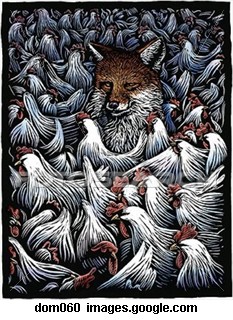 |
When I learned how CEO salaries are determined, I really fully understood the meaning of this expression. That boards are made up of upstanding citizens like CEOs; that CEO 1 sits on Board 2, while CEO 2 sits on Board 1; and that boards set the salaries of CEOs....
It's pretty clear from that much information what can happen: salaries that spiral upward, with each CEO making the other happier and happier. "You scratch my back, I'll scratch yours." The only people who lose are the customers, who pay higher prices for goods, and the stock-holders (although they're assured that, if you want quality, you've got to pay for it....). Here's another example, from the New York Times, 11/15/2011: the headline reads "Doctors Paid for Heart Tests Order More". "Well duh!", we're inclined to shout, but we realize, with regret, that doctors are supposed to be working selflessly for us -- not shilling for their own pocketbooks. Tom and Ray Mariachi (Click and Clack, the Car Guys on NPR's Car Talk) sometimes suggest that the scale and cost of your car repair depend on how much money the mechanic needs to fix his boat.... |
This one is troubling to any Christian. Jesus was a master of asking people to do things which are completely contrary to common sense (but which align, evidently, with the dictates of his religion -- e.g. his advice to the rich man: 'Jesus answered, "If you want to be perfect, go, sell your possessions and give to the poor, and you will have treasure in heaven. Then come, follow me."' -- yeah right! Most people won't trade treasure on Earth for treasure in Heaven. It's a measure of their belief, certainly....).
The Parable of the Workers in the Vineyard.
Matthew 20:
1 For the kingdom of heaven is like a landowner who went out early in the morning to hire workers for his vineyard. 2 He agreed to pay them a denarius for the day and sent them into his vineyard.
3 About nine in the morning he went out and saw others standing in the marketplace doing nothing. 4 He told them, 'You also go and work in my vineyard, and I will pay you whatever is right.' 5 So they went.
He went out again about noon and about three in the afternoon and did the same thing. 6 About five in the afternoon he went out and found still others standing around. He asked them, 'Why have you been standing here all day long doing nothing?'
7 'Because no one has hired us,' they answered.
He said to them, 'You also go and work in my vineyard.'
8 When evening came, the owner of the vineyard said to his foreman, 'Call the workers and pay them their wages, beginning with the last ones hired and going on to the first.'
9 The workers who were hired about five in the afternoon came and each received a denarius. 10 So when those came who were hired first, they expected to receive more. But each one of them also received a denarius. 11 When they received it, they began to grumble against the landowner. 12 'These who were hired last worked only one hour,' they said, 'and you have made them equal to us who have borne the burden of the work and the heat of the day.'
13 But he answered one of them, 'I am not being unfair to you, friend. Didn't you agree to work for a denarius? 14 Take your pay and go. I want to give the one who was hired last the same as I gave you. 15 Don't I have the right to do what I want with my own money? Or are you envious because I am generous?'
16 So the last will be first, and the first will be last.
Yikes! Jesus is saying that the reward of his kingdom is patently unfair! We, Americans, ordinary citizens, we take "fairness" as a bedrock foundation. Jesus sweeps it away. It infuriates some: equal pay for equal work! But Jesus says "equal pay for unequal work!" It's his to pay, afterall....
Jesus answers that he did what is fair -- he gave the workers the sum that was promised them. But they don't see it as fair, when he gives the same to the workers who did less work. The next time, perhaps they'll refuse to come early, but make themselves available later in the day, hoping that they'll get a full day's wages for an hour or two of work.
Wouldn't you agree that this is terrible social dynamics? This one gives me pause....
But Jesus showed an insensitivity to "fairness" in one other important parable from Matthew (25):
The Parable of the Bags of Gold
14 "Again, it will be like a man going on a journey, who called his servants and entrusted his wealth to them. 15 To one he gave five bags of gold, to another two bags, and to another one bag,[a] each according to his ability. Then he went on his journey. 16 The man who had received five bags of gold went at once and put his money to work and gained five bags more. 17 So also, the one with two bags of gold gained two more. 18 But the man who had received one bag went off, dug a hole in the ground and hid his master's money.
19 "After a long time the master of those servants returned and settled accounts with them. 20 The man who had received five bags of gold brought the other five. 'Master,' he said, 'you entrusted me with five bags of gold. See, I have gained five more.'
21 "His master replied, 'Well done, good and faithful servant! You have been faithful with a few things; I will put you in charge of many things. Come and share your master's happiness!'
22 "The man with two bags of gold also came. 'Master,' he said, 'you entrusted me with two bags of gold; see, I have gained two more.'
23 "His master replied, 'Well done, good and faithful servant! You have been faithful with a few things; I will put you in charge of many things. Come and share your master's happiness!'
24 "Then the man who had received one bag of gold came. 'Master,' he said, 'I knew that you are a hard man, harvesting where you have not sown and gathering where you have not scattered seed. 25 So I was afraid and went out and hid your gold in the ground. See, here is what belongs to you.'
26 "His master replied, 'You wicked, lazy servant! So you knew that I harvest where I have not sown and gather where I have not scattered seed? 27 Well then, you should have put my money on deposit with the bankers, so that when I returned I would have received it back with interest.
28 "'So take the bag of gold from him and give it to the one who has ten bags. 29 For whoever has will be given more, and they will have an abundance. Whoever does not have, even what they have will be taken from them. 30 And throw that worthless servant outside, into the darkness, where there will be weeping and gnashing of teeth.'
Each of the other two servants doubled their money: one was simply entrusted with less of it. That the rich man gave all the funds to the one entrusted with more displays a lack of fairness (or a lack of understanding of proportions! -- but I wouldn't want to accuse Jesus of being bad at math -- or bad at anything, for that matter....).
